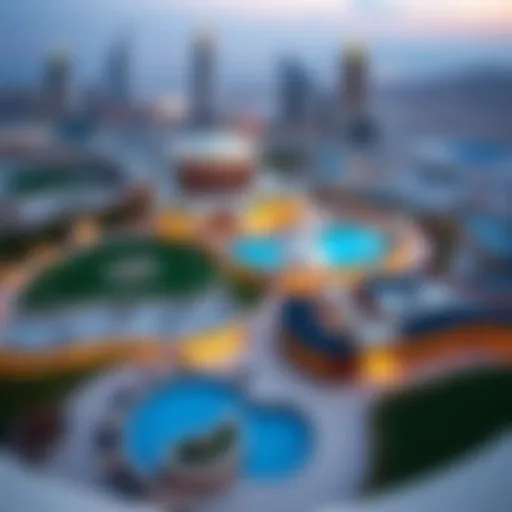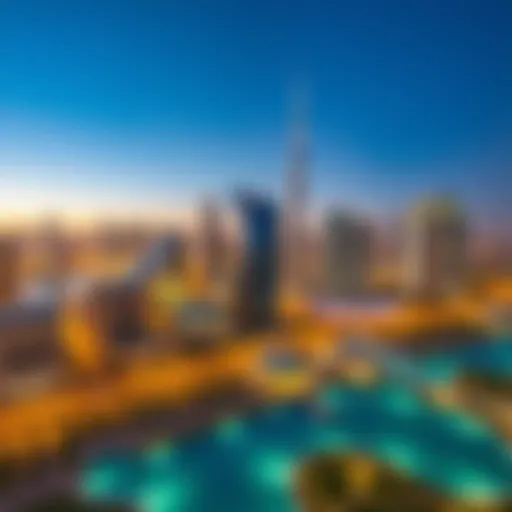Urban Oasis by Missoni: A Design Retreat in the City
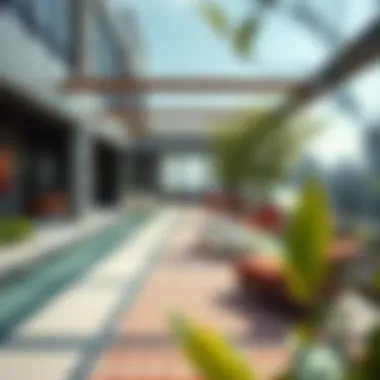

Intro
In the ever-evolving landscape of urban living, the notion of creating a harmonious retreat within the confines of bustling cities has gained ground. Missoni, a brand synonymous with vibrant designs and intricate patterns, steps into this arena with its concept of the 'Urban Oasis.' This approach seeks to blend the liveliness of urban life with a touch of tranquility, providing residents with a slice of serenity in a chaotic world.
As we dissect the layers of this concept, it becomes evident that urban dwellers are yearning for spaces that not only echo their fast-paced lives but also offer moments of reprieve. The interplay between vivid design elements and soothing natural aesthetics can emerge as a vital component in crafting a modern living experience. By integrating aspects of nature, whether through colors or textures, Missoni's philosophy stands out, providing insights into the essential balance needed for urban residents today.
Creating a serene atmosphere amid urban turmoil can transform not just residential spaces but also influence the broader urban fabric. Therefore, in the following sections, we will explore how these designs enhance city living, benefiting both the individual and the community at large. Through this journey, we will aim to illuminate how the 'Urban Oasis' by Missoni appeals not just to emotional needs but also to the practical sensibilities of investors, homebuyers, and real estate professionals seeking quality and meaning in urban environments.
The Concept of Urban Oasis
The concept of an Urban Oasis serves as a beacon for city dwellers yearning for solace amidst the concrete jungle. In an era when cities have become hubs of hustle and bustle, the idea of creating a retreat that resonates tranquility becomes not just appealing, but essential. Urban Oases, which blend vibrant aesthetics with natural elements, reflect a growing recognition of the need for restorative spaces in our lives. By design, these oases aim to harmonize the stimulating pace of urban existence with pockets of peace.
The Urban Oasis stands out for several reasons:
- Psychological Relief: Urban Oases provide respite from the stresses of city life. The soothing effect of greenery, combined with thoughtful design, has been shown to reduce anxiety and enhance a sense of well-being.
- Community Building: Such spaces invite a mingling of different demographics, promoting interactions among residents that might not typically happen. This creates a stronger sense of community and belonging.
- Environmental Benefits: Incorporating nature into urban designs also contributes positively to the local ecosystem. Green roofs and urban gardens support biodiversity and help in mitigating urban heat.
Engaging with the concept of an Urban Oasis starts with recognizing urban space not just as living quarters, but as environments crucial to the quality of life for residents. The psychological benefits of greenery combined with thoughtful design elevate urban living experiences, making these oases more than mere enhancements; they are vital for fostering healthier urban lifestyles.
Defining Urban Oasis
An Urban Oasis can be understood as a space within a city that offers a serene environment, often juxtaposed against a backdrop of urban life. Typically, it encompasses elements such as gardens, green roofs, and pleasant communal areas designed to rejuvenate those who inhabit them. The essence of an Urban Oasis lies in the marriage of nature with contemporary urban architecture, creating spaces that feel both modern and welcoming.
To further clarify, one might think of an Urban Oasis like a patch of grass amid a sprawling parking lot. It’s a reminder that life can thrive even in the harshest environments. This not only serves a functional role but also provides an aesthetic pleasure that enhances urban life's overall quality. The intentional creation of these spaces reflects a broader cultural shift towards valuing wellness, sustainability, and community within urban planning.
Historical Context and Evolution
Examining the historical context of Urban Oases reveals a narrative rich in evolution and adaptation. Historically, city spaces have been dominated by hard materials, with little regard for nature. However, as urban populations began to grow and problems of over-crowding, pollution, and mental health emerged, the need for harmonious spaces surfaced.
The early 20th century marked a transformative period for urban design, as ideas around landscape architecture evolved. Architects sought to incorporate green spaces into cities, inspired by movements like the City Beautiful Movement, which advocated for aesthetically pleasing public spaces. Fast forward to the 21st century, the emergence of concepts like biophilic design—the integration of natural elements into architecture—now shapes modern urban planning.
Today’s Urban Oases are a blend of innovation and tradition, drawing from historical contexts while looking ahead. Innovations like vertical gardens and co-housing projects exemplify how practical urban solutions can nurture community and environment simultaneously. The drive towards sustainable practices enhances the urgency and relevance of creating urban retreats today.
"An Urban Oasis is not just a place but a paradigm shift in how we view and design our living environments."
The evolution of the Urban Oasis reflects changing societal values towards health, nature, and community, indicating a sustained and growing interest in cultivating these sanctuaries in our bustling cities.
Missoni's Aesthetic Philosophy
Missoni's approach to aesthetics transcends mere decoration; it embodies a vibrant philosophy that intertwines artistry and functionality. This philosophy is essential to the concept of Urban Oasis, as it blends the artistic expression of Missoni's signature styles with the practical needs of urban living. In a world filled with monotony, Missoni seeks to enliven spaces, bridging the experience of design and the natural world.
Brand Overview
Founded in 1953, Missoni has carved a unique niche within the fashion and design industries. Renowned for its knitwear, the brand transitioned seamlessly into home décor, offering textiles that are as expressive as they are functional. Missoni's hallmark is its use of bold colors and abstract patterns, which not only captivate the eye but also evoke emotion. This approach to design invites inhabitants to feel an intrinsic connection to their surroundings. For investors, homebuyers, and developers, understanding this aesthetic translates to recognizing the added value and desirability it brings to residential spaces. Missoni's designs encourage the blending of art with daily life, pushing urban dwellers to engage with their environments in meaningful ways.
Signature Patterns and Vibrancy
Missoni's patterns are distinguished by a chaotic harmony that often feels spontaneous yet meticulously crafted. The unique zigzags, florals, and geometric arrangements are not mere decorations but become part and parcel of the emotional landscape. These designs stimulate senses and spark conversations, enhancing the ambiance of any urban space.
Each piece is a celebration of color, which carries its own rhythm and personality. For instance, warm shades may evoke comfort, while cooler tones can inspire calmness. This interplay of hues and designs is critical in Urban Oasis developments as it directly addresses the emotional wellness of residents. By employing Missoni's signature vibrancy, developers can create a welcoming haven that stands out against the backdrop of concrete jungles.
"Design is not just what it looks like and feels like. Design is how it works."
- Steve Jobs
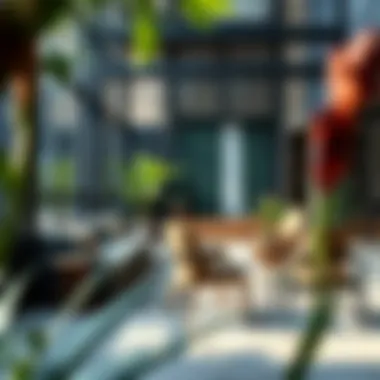

Utilizing Missoni’s designs, real estate projects can harness the psychological benefits of color and form, offering not just living spaces but emotional retreats. For those seeking refuge from the frenetic pace of urban life, Missoni’s aesthetics provide the perfect antidote, making such properties not just homes, but true urban oases.
Integration of Nature into Urban Design
Crafting an urban oasis means weaving together the chaotic elements of city life with soothing aspects of nature. This integration holds profound significance, especially considering modern urban dwellers who often seek respite from the relentless pace of urban living. In this section, we will explore how urban design can embrace nature, detailing the principles that underpin this approach as well as the vivid colors and textures that underscore its appeal.
Biophilic Design Principles
Biophilic design is more than a buzzword; it’s a philosophy aimed at reconnecting people with nature. This approach promotes well-being through a conscious integration of nature in architecture and landscapes. Research suggests that people living in environments rich with natural elements report improved health and reduced stress levels. Here are some key tenets of biophilic design:
- Natural Lighting: Large windows, skylights, and open spaces that increase the influx of natural light contribute significantly to a sense of well-being.
- Indoor Gardens: Incorporating plants inside residential and commercial spaces creates a seamless transition between indoors and outdoors.
- Natural Materials: Utilizing materials like wood, stone, and bamboo not only enhances the aesthetic but also promotes a connection to the natural environment.
Through these principles, developers and designers can create spaces that resonate with the innate human connection to nature, paving the way for more tranquil urban lifestyles.
Use of Color and Texture
The vibrancy of colors and the richness of textures in urban design serve not just an aesthetic purpose; they also influence mood and perception. Missoni’s signature patterns naturally lend themselves to lively urban spaces, but the choices made go beyond mere visual appeal.
- Colors: Bright hues often mimic elements found in nature, such as the blues of the sea or greens of forests. This not only livens up a space but also instills a sense of freshness and vitality. Urban dwellers can benefit greatly from a palette that reflects the natural world around them.
- Textures: Textural variety introduces depth and tactile stimulation. This can range from the rough, organic textures of rocks and wood to the smoothness of glass and metal. A well-thought-out combination of textures can stimulate a sensory experience, offering feelings of warmth and comfort amidst the urban environment.
In summary, the integration of nature into urban design is not just an aesthetic venture; it’s a pathway to creating healthier, more vibrant living environments. As we delve deeper into the topics surrounding urban oases, understanding the role of biophilic design and the effective use of color and texture will be crucial in appreciating how these elements contribute to urban tranquility.
"The more we can create environments that connect people to nature, the more we can nurture human health and well-being in urban settings."
For further reading on biophilic design principles and more insights into urban planning, you can explore resources at Wikipedia or academic articles found on Britannica.
Becoming adept at integrating nature requires careful planning and implementation, but the potential benefits—from psychological uplift to improved community engagement—are worth the effort.
Creating Tranquility in Urban Environments
Urban life, often bustling and fast-paced, presents a stark contrast to the peaceful experiences that tranquility offers. As cities expand and evolve, the overwhelming presence of noise, traffic, and concrete structures can wear down even the most resilient spirits. This is where the concept of urban retreats enters the scene, a necessity rather than a luxury in designing spaces that nurture calmness amidst the chaos.
A serene environment does not merely serve to relax the mind; it actively contributes to better mental health and emotional well-being. Creating tranquil spaces is essential for improving the quality of life for residents while also enhancing property values for investors and developers alike. The benefits encompass various dimensions, from physical health promotions such as reduced stress levels to promoting community well-being through shared, peaceful spaces.
Design Techniques for Calm Spaces
When it comes to designing calm spaces, various techniques can be employed to foster peace. Just as a painter utilizes a palette for their artwork, a designer can draw on elements that evoke tranquility. Here are some effective techniques:
- Color Psychology: Utilize softer, muted colors like pale blues, greens, and earth tones. These shades can bring about a sense of relaxation. Missoni's distinctive use of color provides a lively twist while maintaining a moderated tone, striking a balance between vibrancy and serenity.
- Natural Materials: Incorporate wood, stone, and other natural elements. Textures contribute to a sensory experience, allowing for a connection to nature even within urban confines. Think wooden furniture or natural stone countertops.
- Soft Lighting: Lighting plays a significant role in setting the mood. Intermittent light through different fixtures can create layers, while dimmable options enhance the feeling of calmness. Avoid harsh fluorescents; instead, opt for warm-toned lights.
- Layout and Flow: Design floor plans that facilitate movement and create open spaces. Cluttered designs can lead to feelings of chaos. Open layouts with sufficient room for air to circulate and pathways to flow can drastically increase feelings of peace.
Incorporating these design techniques ensures that spaces, though eclectic and vibrant, do not become overwhelming. Development projects by brands like Missoni embody this philosophy, translating the idea of peaceful living into tangible, serene spaces.
Incorporating Green Spaces
Green spaces are medicinal in urban contexts, acting as refuges from the concrete jungle. This phenomenon, often termed as biophilia, relates to the innate connection humans have with nature. The inclusion of green areas, whether through gardens, green roofs, or indoor plants, serves multifaceted roles in urban environments.
- Stress Reduction: Studies show that access to green spaces can lead to lowered stress levels and enhanced emotional well-being. People find solace in greenery, leading to better mental health outcomes.
- Community Connection: Places like parks not only promote individual relaxation but also foster community engagement. Such areas become gathering spots that encourage socializing, nurturing a sense of belonging.
- Environmental Benefits: Green spaces help improve air quality by filtering pollutants and providing shade, contributing to a cooler microclimate within urban areas. They can also assist in managing urban runoff and improving the biodiversity of local ecosystems.
- Designing with Nature: In Missoni's projects, green spaces become integral features rather than afterthoughts. Gardens, terraces, and landscaped areas that honor nature’s blueprint can create a holistic atmosphere.
Integrating these natural elements into urban designs is not just about aesthetic appeal; it’s about creating a lifestyle choice that advocates for wellness. Not only do they beautify space, but they herald a future where nature and urban living coalesce harmoniously.
The Role of Urban Oases in Real Estate
Urban oases serve as vibrant sanctuaries within crowded city landscapes, transforming how people perceive urban living. With rapid urbanization causing more concrete jungles to sprout, the demand for these serene escapes is becoming increasingly pronounced. As cities strive to enhance livability, integrating distinct, nature-infused designs not only beautifies the space but also elevates its value in the real estate market. This section delves into the myriad ways urban oases impact real estate, exploring market trends and opportunities as well as their appeal to potential buyers and renters.
Market Trends and Opportunities
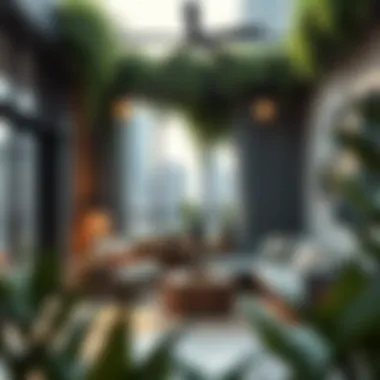

The real estate market is shifting dramatically due to the ascendancy of urban oases. As more developers recognize the need for green, restorative spaces, there's been a notable uptick in projects that emphasize biophilic design. In recent years, several trends haved emerged:
- Increased Demand for Green Spaces: Homebuyers and tenants are actively seeking properties with access to parks, gardens, or communal outdoor areas that foster a sense of community.
- Premium Pricing for Nature-Inspired Developments: Properties that incorporate urban oases often command a higher price point, as people are willing to invest in tranquility amidst the hustle and bustle of urban life.
- Sustainability as a Selling Point: Environmentally conscious buyers are attracted to developments that showcase sustainable practices and materials, thereby ensuring long-term environmental health and personal well-being.
These trends signal a growing realization among investors regarding the lucrative opportunities offered by urban oases, paving the way for future projects to reflect similar principles.
Appeal to Buyers and Renters
For prospective residents, the allure of urban oases is palpable. Whether one is looking to buy or rent, several aspects contribute to this appeal:
- Enhanced Quality of Life: Access to serene spaces positively influences mental health and overall well-being. Residents feel less stress and more connected to nature, even while surrounded by skyscrapers.
- Community Building: Urban oases encourage social interactions and create a sense of belonging. Public spaces within these developments often host community events, enhancing local ties.
- Aesthetic Appeal: Properties that incorporate unique design elements and vibrant colors, characteristic of Missoni's influence, stand out in the market, thereby attracting discerning homebuyers and renters looking to make a statement.
"Urban oases are not just an extra feature; they are becoming a fundamental component of successful real estate developments, appealing to those who value serenity in an urban context."
As more individuals recognize the benefits of such designs, the market for urban oases will continue to thrive, presenting exciting opportunities for developers and investors alike.
Missoni's Urban Oasis Projects
In the context of urban life, Missoni's approach to design becomes an essential conversation starter. The developments that carry the Missoni hallmark embody the principles of comfort and style, merging luxury with the calmness that urban spaces often lack. Missoni's Urban Oasis projects are vital as they reflect not just a choice of aesthetic but a way to enhance living conditions in cities inundated with concrete and noise.
Missoni emphasizes integrating vibrant colors and nature-inspired textures, creating retreats that soothe the soul. This melding of elements speaks to both the eyes and the heart, offering a sanctuary from the frenetic pace of urban life. Homebuyers and investors alike see the potential in these projects not just for their immediate appeal but for their lasting impact on well-being and community.
Overview of Featured Developments
Many of Missoni’s projects showcase their vision of the Urban Oasis. One notable example is the Missoni Baia in Miami, which illustrates their commitment to merging contemporary design with the natural environment. It encompasses spacious terraces with lush greenery that enhance the ocean views, providing a seamless transition from vibrant interiors to calming outdoor spaces.
Another example is the Missoni Home Collection, where the brand extends its vibrant flair into urban living. Each piece echoes the colors of nature while maintaining that unmistakable Missoni twist. This reveals an understanding of how design transcends mere visuals; it’s about crafting experiences that resonate deeply with residents.
The incorporation of eco-friendly materials and smart technology into these developments also highlights a commitment to sustainability—a key factor for today’s buyers looking to invest in future-proof properties. With features that promise energy efficiency, these properties reflect an awareness of environmental responsibilities while enhancing marketability.
"Missoni's approach is not merely about making an aesthetic statement. It’s about creating havens in urban jungles where people can truly feel at home."
Case Studies of Successful Implementations
Looking closely at successful implementations of Missoni's Urban Oasis reveals how thoughtful design elements cultivate a sense of community and identity. The Missoni Garden Apartment in Milan stands out as a case study worth noting. This development integrates residential spaces surrounded by communal gardens and relaxing areas. This not only fosters social interaction but also redefines urban living by encouraging a connection to nature.
Another noteworthy project is the Missoni Residences in Dubai, where the synergy between architecture and landscape design is palpable. Featuring extensive balconies adorned with plants and flowers, it symbolizes a modern lifestyle that embraces both luxury and environmental awareness. Buyers are attracted to these residences, not just for their stylish interiors but for the lifestyle they promise—one where access to nature is just a step away.
A careful examination of these examples illustrates a trend: the more homeowners engage with their surroundings, the more likely they are to invest in that space. The community environment fostered in Missoni’s Urban Oasis projects makes them particularly appealing to expats and urban dwellers looking for respite from their daily routines.
Impacts of Urban Oasis Designs
Urban oases crafted by Missoni represent more than just a creative approach to architecture and design; they symbolize a crucial shift towards a lifestyle that prioritizes both aesthetics and well-being within the hectic rhythm of city life. The various impacts, specifically in terms of psychological benefits for residents and enhanced community engagement, underlie the essence of an urban oasis.
Psychological Benefits for Residents
In the cacophony of urban existence, the subtle power of beautifully designed retreats can’t be overstated. Urban oases provide a much-needed sanctuary, fostering mental wellness among residents.
- Stress Reduction: Research links exposure to green spaces with lowered stress levels. Missoni’s design ethos imbues spaces with biophilic elements—think lush greenery nestled amidst modern architecture—that invites serenity.
- Mood Improvement: Bright colors and interesting patterns can elevate spirits. For instance, Missoni's trademark vibrant textiles used in interior and exterior designs play a significant role in creating a cheerful ambiance, counterbalancing the grayscale feel often present in urban settings.
- Mindfulness and Relaxation: Dedicated areas for reflection, like tranquil gardens or zen-like outdoor lounges, urge residents to pause and interact with their surroundings thoughtfully. This can lead to enhanced emotional well-being.
These aspects meld together to create a living space that prioritizes mental health, marking themselves as essential components in modern residential offerings.
Enhanced Community Engagement
Beyond the individual benefits, urban oases have remarkable potential to strengthen community ties. A harmonious retreat not only serves its residents but also acts as a communal hub, fostering connection.


- Social Interaction: Design elements that encourage gathering, like shared terraces or communal gardens, become breeding grounds for neighborly camaraderie. Local residents can bond over gardening tasks or simply enjoy the open air together.
- Cultural Exchange: Missoni’s international flair can be mirrored in communal spaces decorated with local art, creating unique environments where residents appreciate diverse cultures. These spaces enable residents from different backgrounds to collaborate, share stories, and engage with one another meaningfully.
- Community Events: Spaces that allow for events like farmers' markets or open-air film nights cultivate a sense of belonging. These collective experiences bridge gaps amongst residents, fostering harmonious interactions that can combat feelings of isolation in the urban backdrop.
"A well-designed urban oasis does not merely offer a reprieve from chaos; it enhances our collective identity and creates a shared sense of purpose."
Challenges in Implementing Urban Oases
Creating an urban oasis is no walk in the park. While the concept is idealistic, the real-world implications often clash with the vision. The challenges lie not simply in the artistry of design but in the combination of practicalities and urban rough-and-tumble. Investors, homebuyers, and developers might envision a vibrant retreat amid the concrete jungle, yet these aspirations can easily run into roadblocks—often significant ones.
Site-Specific Constraints
One major hurdle in urban oasis development is the site-specific constraints that can make or break a project. Every location has its unique characteristics that require tailored solutions. For instance, older districts with limited space can hinder the integration of multi-functional green areas.
- Zoning Regulations: Zoning laws can act as gatekeepers, enforcing strict guidelines on how space can be used. These laws often prioritize commercial developments over residential greenery, complicating efforts to create inviting ecosystems.
- Topography: Some sites might suffer from uneven ground, which poses challenges in leveling areas for gardens or natural landscapes. This can make it tricky to design anything that feels cohesive.
Furthermore, existing infrastructure might need to adapt to new designs, leading to increased costs and extended timelines. For example, adding a green roof to a building in an already crowded area may mean reinforcing the building, which can be a costly venture.
Balancing Aesthetics and Functionality
Then there’s the delicate dance of balancing aesthetics with functionality. It’s all well and good to dream of lush, colorful landscapes; however, they need to serve practical purposes too.
- Maintenance Issues: A beautifully designed oasis that requires excessive upkeep can quickly become a liability. Homebuyers and tenants want low-maintenance options. If an urban garden becomes a hassle, the allure can dissipate faster than morning mist in the sun.
- Audience Expectations: The target demographic also plays a crucial role here. Investors must research to understand what prospective residents seek. They might want a cozy reading nook surrounded by greenery, while others might desire communal spaces that cater to social interactions. Achieving a balance that satisfies various preferences becomes paramount.
"The essence of an urban oasis lies not only in its beauty but also in its utility—designing an oasis that thrives hinges on understanding the urban environment and its inhabitants."
Future of Urban Oases in City Planning
As cities grow and urban spaces become increasingly congested, the notion of Urban Oases is gaining traction. These havens within the concrete embrace of metropolitan life promise not only a retreat for weary city-dwellers but also a shift in how we conceive urban living. By integrating nature into the core of city planning, the future of Urban Oases reflects a reimagined urban landscape that prioritizes well-being, sustainability, and community interaction.
Innovative Trends in Urban Design
In recent years, innovative trends in urban design have emerged, aimed at creating spaces that resonate with nature while maximizing the use of available resources. Some notable trends include:
- Vertical Gardens: High-rise buildings featuring lush gardens not only beautify but also improve air quality, enhancing the overall urban experience.
- Mixed-Use Developments: Spaces that fuse residential, commercial, and recreational areas to foster a vibrant community atmosphere, promoting social interaction and reducing the need for long commutes.
- Smart Cities: Integration of technology in urban design allows for better resource management, including energy-efficient buildings, improved waste management systems, and enhanced public transportation options.
- Walkable Neighborhoods: Design that encourages walking and cycling, incorporating pathways and green spaces, makes for a healthier lifestyle and reduces the carbon footprint of the community.
These design trends underline the notion that a harmonious coexistence of environmental consciousness and urban living is not just possible, but essential for future city developments.
Potential for Sustainability Initiatives
The potential for sustainability within Urban Oases is not merely a buzzword; it’s a necessity rooted deep within the fabric of urban planning. Sustainable initiatives can transform urban settings into ecological arenas. Here are several pathways to pursue this potential:
- Renewable Energy Sources: Incorporating solar panels, wind turbines, and other renewable energy sources into urban structures.
- Water Conservation: Implementing systems for rainwater harvesting and greywater recycling, ensuring that water usage is minimized.
- Biodiversity Promotion: Creating habitats for local flora and fauna, helping to restore ecosystems that urban development has compromised.
- Community Gardens: Promoting local food production can not only support sustainability but also instill a sense of community among urban residents.
- Sustainable Materials: Utilizing recycled and eco-friendly materials in construction contributes to a lower environmental impact.
"The challenge lies in marrying these sustainability initiatives with practical urban living, ensuring that function meets form without compromising either."
Finale
In summarizing the concepts explored throughout this article, the significance of the Urban Oasis not only resonates with the aesthetic aspirations of Missoni but also addresses a pressing need for creating havens amid urban chaos. The harmony between vibrant design elements and tranquil living is a testament to how spaces can be transformed, seamlessly integrating nature's beauty into the concrete jungle.
Reflecting on the Urban Oasis Concept
The Urban Oasis concept invites us to rethink our relationship with the environment, particularly in densely populated areas. By incorporating natural elements such as greenery, water features, and open spaces, these designs encourage a renewal of our connection with nature. This idea is further backed by biophilic design principles, which underscore that human mental health flourishes in proximity to nature.
Moreover, the emergence of Urban Oases stands as an innovative solution to urban issues, promoting not just aesthetic value but also social cohesion and well-being. Residents find themselves more at ease, fostering community through shared spaces that are both functional and soothing. When individuals feel nurtured by their environment, it cultivates a sense of identity and belonging—elements that are especially pivotal in today’s transient urban life.
The Lasting Influence of Missoni
Missoni’s influence in the world of Urban Oases stretches beyond vibrant patterns and colors. The brand has managed to weave emotional connections into its design philosophy. By focusing on elements that instill joy and comfort, Missoni imparts a unique perspective on urban living. Their contributions have altered perceptions of potential living environments, nudging both designers and residents to consider the profound impact of aesthetic choices on day-to-day life.
As cities continue to evolve and the demands on living spaces intensify, the principles embodied by Missoni could lead to a more sustainable urban future. This involves not just satisfying housing requirements but also nurturing the environment and community spirit.
In summary, the synergy between the Urban Oasis concept and Missoni's ethos presents a pathway towards urban planning that cherishes aesthetics, functionality, and psychological well-being. The implications for housing market trends are significant, particularly as more urban dwellers seek meaningful, tranquil settings. As we reflect on these themes, it becomes clear that the integration of urban oases is not merely a design trend but a necessary evolution in how we approach urban living.













